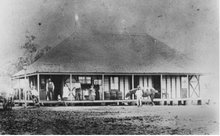Imagine arriving from Germany, in clothes that would have been suitable for a northern climate. Most fabrics were still made of wool. Women and girls wore woollen stockings and underwear. Men had their woollen trousers, long-sleeved shirts and jackets. Clothing, especially for working class people was dark. A good example is this photo of Wilhelm and Wilhelmine was probably taken soon after their arrival here, to send back home to Germany.

Here too is a photograph of Anna and a younger sister, probably taken at the same time. I am struck by her dark attire and serious demenour, but then portraiture was a serious business then and she was probably quite uncomfortable in her best clothes.

Most of the year here, daytime temperatures are mid-twenties (degrees centigrade) and upwards. The weather forecast for the coming Saturday and Sunday says “Dry and cool. Maximum temperatures 27C-28C.” This last week we have had daytime highs of 35C and it isn’t high summer yet. Our winters are mild and last for a couple of months. Even with cool overnights and frosts, daytime temperatures are in the mid-twenties. Clothing suitable for Germany would have been totally unsuitable here. I noticed in later photographs of Anna’s family, that people are more comfortably attired: the women in ¾ length skirts and blouses, the men in suits, girls in light dresses and socks rather than stockings and boys in shorts albeit worn with a suit jacket. Part of this would be changing fashions, part the demands of the climate. But it is clear that people quickly adapted to the new country.

No comments:
Post a Comment